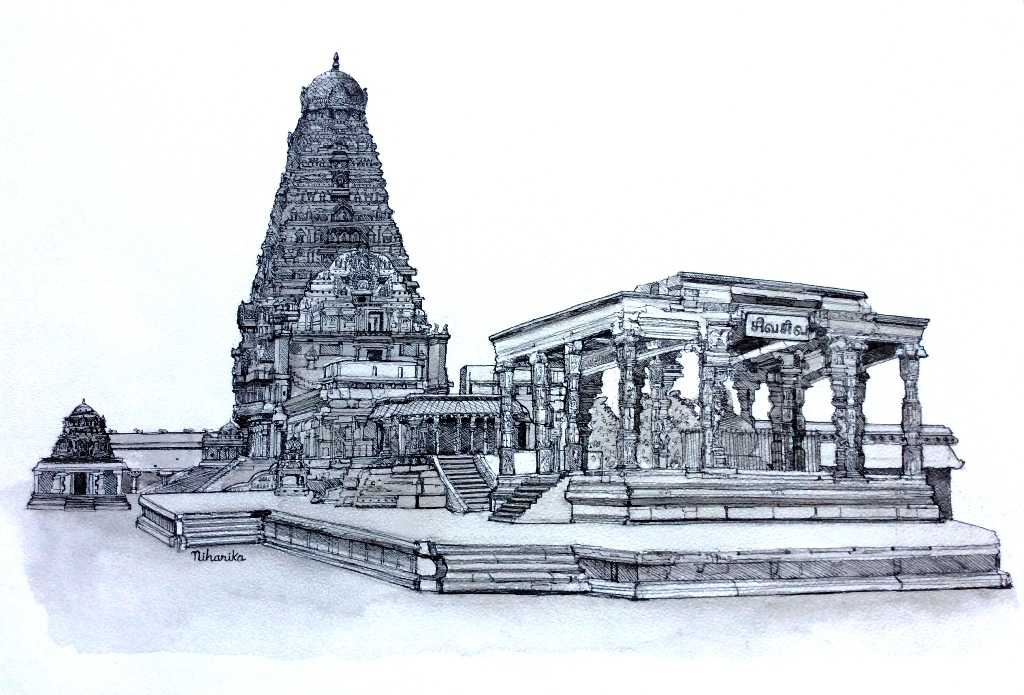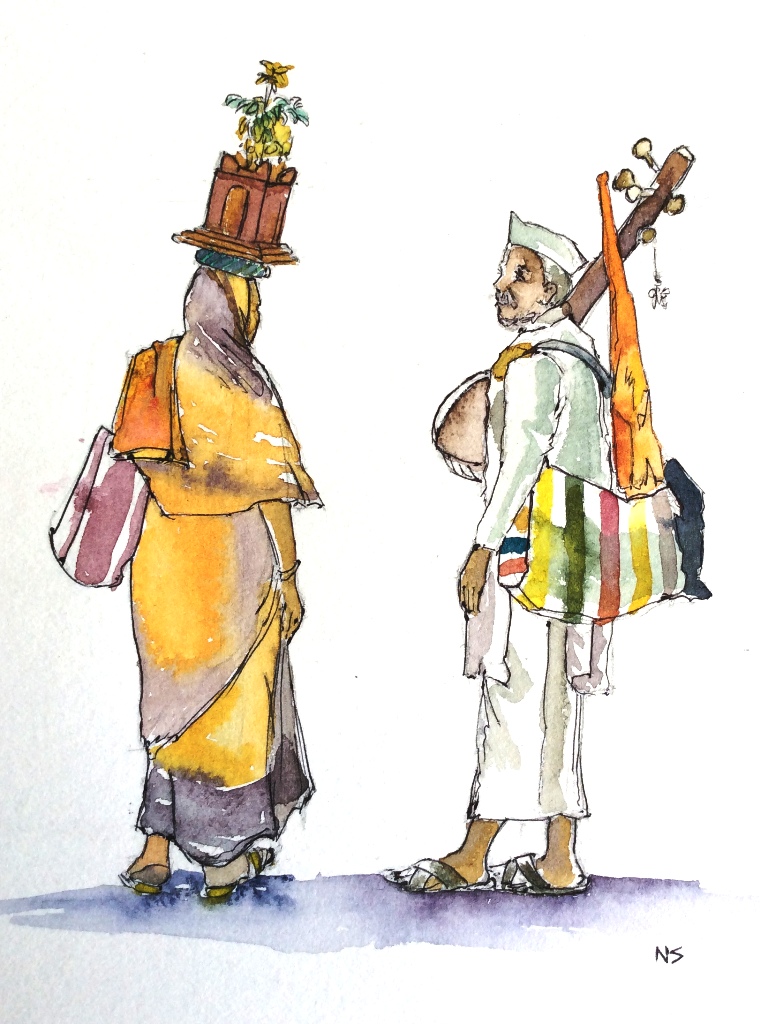Discover Stories in the Archives
 |
| Representative Illustration © Niharika Shenoy |
Outspoken, sensitive, easily offended yet deeply vulnerable; curious, sharp, and lovable—these are the shifting hues that come to mind when I think of adolescents. It’s endearing to see personalities peeking out, forming and dissolving in the short span of our interactions, surprising and humbling me with the depths they contain. They remain my favourite age group to explore ideas with: old enough to grasp nuances on their own, yet not too world-weary to try new things.
This blend of intensity and openness is exactly what makes them such great companions in a space like the Archives at NCBS, where I watched twelve young visitors mingle with an effortless ease - the kind that only comes from being raised in an environment where self-expression is encouraged.
 |
| PC - Sahamatha |
We began the workshop with an unconventional icebreaker: participants were invited to jot down eleven things about themselves they wished the world to know. These could be as lofty as hopes and dreams, as everyday as likes and dislikes, or as surprising as little-known quirks. The openness of the task gave them room to wander in any direction they chose. The aim was to draw out different facets of their personalities on paper, expressed through both words and doodles. Writing helped them put ideas down without the hesitation of ‘I can’t draw’ while drawing revealed their approaches to world-building and self-representation through objects, clothes, and tools. This exercise proved especially useful as a lead-in to the workshop’s main discussion.
 |
| PC - Sahamatha |
Then began an interactive session of self-introduction. I enjoyed seeing the juxtaposition of seemingly contradictory things and the complexity of every individual. Some spoke with refreshing honesty and guilelessness, which I deeply valued—it created a sense of trust and rapport far more quickly than I had expected.
 |
| PC - Ravi Kumar Boyapati |
 |
| PC - Sahamatha |
With this context in place, the participants were divided into two groups and led to tables displaying eleven objects linked to an unknown figure—letters, photographs, manuscripts, field notes, artist proofs, books, and clippings.
 |
| PC - Ravi Kumar Boyapati |
Their task was to observe, interpret, and assemble clues to uncover whose life the materials revealed. Sahamatha and I guided each group, gently steering the discussion with questions. They were asked to compile a list of 11 things they wanted the world to know about this unknown figure, grounding each point in facts drawn from the archives.
 |
| Picture Source: Mathrubhumi.com |
 |
| Carl D'Silva ( Source: Archives at NCBS) |
Facilitator: What is their name?
Participant A: Salim Ali. (Pointing to the name prominently displayed on the book.)
Facilitator: What makes you think it is Salim Ali? Are there other sources that can verify this?
Participant B: (Shaking her head) No, I don’t think so. I think it’s Carl D… what is this name? (Pointing it out to the facilitator.)
Facilitator: Carl D’Silva.
Participants C & D: Yes, yes—Carl D’Silva. His name appears in more news clips than Salim Ali.
Facilitator: Is it a man or a woman?
All Participants: A man. All these photos show a man.
Facilitator: Do certain words or images repeat throughout these 11 items?
Participant B: Birds, binoculars. I think he is a scientist who researches birds.
Participant C: Yes, he researches birds. He has made detailed drawings, like the structure of a bird’s beak. In this photo, he is examining a bird’s throat—I think it’s a क्रोंच पक्षी (Sarus crane).
Participant D: (Pointing to a sketch) This is a drawing of a person, like a portrait that artists make. But this sketch looks different from his other ones.
Facilitator: Which part of the country is he from?
Participant A: I think he is not from India. I read here that he travelled to foreign countries. It says ‘Born in Caran….’ I can’t read it.
Facilitator: Caranzalem?
Participant A: Yes, Caranzalem. I don’t think there is a place like that in India.
Participant D: I think he is from Goa.
Participant B: He is from Mumbai.
Facilitator: What makes you say that?
Participant D: I’m not sure. The name sounds Goan. I think I read it somewhere.
Participant B: I read that he grew up in Bombay. See here: ‘Bombay Natural History Society staff artist.’ So I think he is from Bombay.
Facilitator: What do you think he likes to do?
Participants: He likes birds. He studies them and likes to draw them.
Facilitator: Which time period did he live in?
Participant A: 1986, 1989.
Facilitator: You mean he was born in 1986?
Participant B: Look here, in this news article : ‘In 1982, at the age of 19, he met the renowned Indian ornithologist Dr. Salim Ali.’ If he was 19 in 1982, he must have been born in… (looks at a friend).
Participant A: 1982 minus 19… he was born in 1963.
Facilitator: Do all of you agree that he was born in the 1960s?
All Participants: Yes, we agree.
Facilitator: What does a day in his life look like?
Participants: He would go to the Bombay Natural History Society, take his books, and research birds outdoors. He seems to have spent a lot of time in the wild.
Facilitator: What objects, tools, or possessions are shown with him?
Participants: He wears clothes suited for the outdoors—shorts, binoculars, jacket, goggles, cap.
Facilitator: Do you think he had a family?
Participant A: I don’t think so. I think he lived alone.
Facilitator: What makes you say that?
Participant A: In all his pictures, he is alone.
Participant B: So what? These photos might have been taken at an institute, like how we are here at NCBS. Just because we appear alone in pictures here doesn’t mean we don’t have families back home in Raipur?
Facilitator: What do all of you think—did he have a family?
Participants: We are not sure. There’s no mention of it here. Maybe, maybe not.
At the end of the activity, we gathered together as each group presented its findings, backing up their claims. We cleared up a few doubts and set the record straight when they were unsure of something.
It was my first time facilitating a workshop like this, and I was worried that the language gap—the participants were more comfortable in Hindi while the material was in English—might hold them back. To my relief, they engaged deeply, showing genuine curiosity as they donned a detective’s hat and pieced together a personality from the odd fragments at hand. I also saw how much the facilitation shapes the conversation, guiding participants toward sharper observations and deeper insights.
 |
| PC - Ravi Kumar Boyapati |
The workshop was truly interesting, and I can already see myself drawing on it when I engage with history. As Sahamatha put it so clearly, the intention was twofold: to look at history not just as a list of facts, but as a treasure chest of stories—alive, dynamic, and open to many interpretations; to see historical figures as real, complex people, as multi-faceted as any of us, so that we can appreciate the weight of their contributions, whether celebrated or little-known.
That afternoon, the Archives felt less like a repository and more like a meeting ground between lives past and present — proof that history breathes more vividly when young people are invited to engage with it.



Comments
Post a Comment